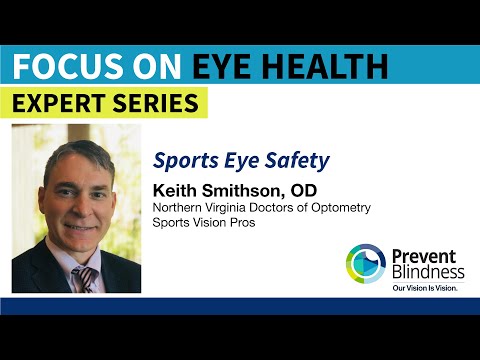The new Prevent Blindness data showed once again that the category of “non-powder guns, darts, arrows, and slingshots” had the overall highest rate of eye injuries. For children ages 0-14, “pools and water sports” had the highest rate of injuries. Types of sports-related eye injuries include blunt trauma, penetrating injuries, eye infections, and corneal scratches and abrasions.
According to Keck Medicine of USC, athletes may also be at risk for a Radiation Eye Injury. Prolonged exposure to the ultraviolet rays of the sun can be incredibly harmful to vision. Athletes who play in water or snow sports, such as surfing or snow skiing are exposed to bright glaring sunlight that reflects off water or snow, increasing the risk of vision loss or damage.
Prevent Blindness strongly recommends that athletes of any age wear protective eyewear when participating in sports. Athletes should always consult an eyecare professional to determine the best kind of eye protection for their sport and medical needs. Fortunately, according to the National Eye Institute, wearing the right protective eyewear can prevent 9 out of 10 sports-related eye injuries.
For parents/caregivers of children involved in sports, Prevent Blindness recommends:
- Parents, teachers, school nurses and coaches should learn about the eye injury risks associated with sports before allowing children to participate.
- Parents should consult an eye doctor for protective eyewear recommendations before enrolling a child in any sports program.
- Parents should only enroll children in after-school organized sports through school districts, community centers, park districts and recreation centers where adults supervise all sports activity. Ideally, an adult trained in the prevention, recognition and immediate care of an eye injury should always be present.
- Parents should meet with a child’s coach or athletic trainer to make sure that proper procedures are in place to deal with a child’s eye injury should one occur.
- Parents, teachers, school nurses and coaches should familiarize themselves with the warning signs of an eye injury and know when to seek treatment.
Prevent Blindness and Rec Specs are partnering during September’s Sports Eye Safety Month to promote education and awareness on ways to protect vision. To download free educational and promotional materials, including the Sports Eye Safety Guide from Liberty Sport, the company behind Rec Specs, visit LibertySport.com/resources, or contact Jon Phillips at (973) 882-0986 x113, or [email protected]. Social media toolkits are also available by request.”
“A sports-related eye injury can happen in an instant, but the effects may last a lifetime,” said Todd. “Team up with your eye doctor to find the best sports eye protection to help keep you in the game today and save your sight for the future.”
For more information on sports eye safety and injury prevention, please visit Prevent Blindness at PreventBlindness.org/sports-eye-safety.
About Prevent Blindness
Founded in 1908, Prevent Blindness is the nation’s leading volunteer eye health and safety organization dedicated to fighting blindness and saving sight. Focused on promoting a continuum of vision care, Prevent Blindness touches the lives of millions of people each year through public and professional education, advocacy, certified vision screening and training, community and patient service programs and research. These services are made possible through the generous support of the American public. Together with a network of affiliates, Prevent Blindness is committed to eliminating preventable blindness in America. For more information, visit us at PreventBlindness.org, and follow us on Facebook, X, Instagram, Threads, LinkedIn and YouTube.
Media Contact
Sarah Hecker, Prevent Blindness, 312.363.6035, [email protected], PreventBlindness.org
SOURCE Prevent Blindness


